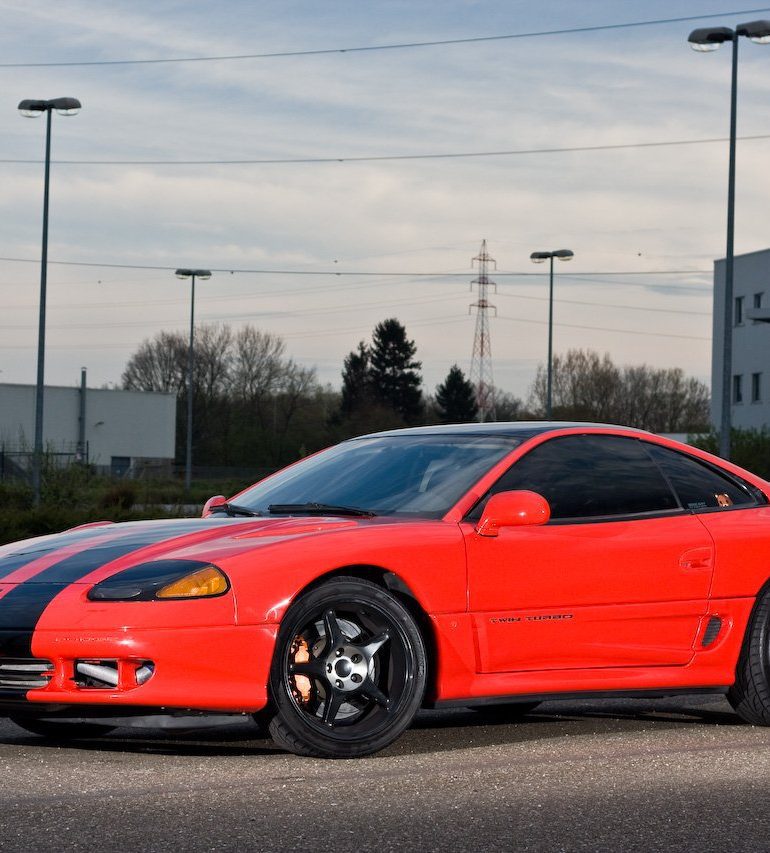When you think of Dodge, you’re probably thinking of big trucks and certain types of snakes. Known far and wide for their monstrous (and monstrously powerful) Hemi, Dodge is a brand that has tied their name to big, loud, and torquey V8 and V10 engines.
However, there was a time when Dodge played around with turbochargers and all-wheel-drivetrains. It was during this time that you could find quirky, albeit flawed, cars like the Omni GLH – a small hatchback christened “Goes Like Hell” by Carroll Shelby – and the Dodge Stealth – a twin-turbocharged six cylinder grand tourer.
A Car With Japanese Roots
The Stealth was the sister car of the Mitsubishi 3000GT. Like the 3000GT, the Stealth was available in FWD or AWD configurations. Also, like the Mitsubishi, the Dodge could be found with a 3L V6 that made 164 horsepower/184 lb-ft torque, a version with 220 horsepower/201 lb-ft of torque, or a 300 horsepower twin-turbo V6 funneling its power to all four wheels.
America was first introduced to the Stealth in 1990, and it was for sale alongside other grand tourers from Japanese, European, and American brands. Turbochargers were making a name for themselves as efficient power adders, with cars like the Mitsubishi Eclipse, Toyota MR2, and Mazda RX7 showing that there was value in – and a market for – cars that ditched the V8 and used smaller, more efficient configurations.
Both the Stealth and the 3000GT Had Serious Performance Potential
In the early to mid-1990’s, a 300+ horsepower car was considered quite the machine. The Ferrari F355 Berlinetta produced 380 horsepower at a price much higher than the Stealth/3000GT, and there was something to be said about Japanese reliability.
The top-trim featured a 24v 3.0L V6 that produced 300 horsepower, though the refreshed models from 1994-1997 saw a nominal bump to 324 horsepower. It wasn’t just fast on paper, it was fast on the road, too:
- 0-60 mph took just 5.4 seconds
- The quarter mile flew by in 14.2 seconds (13.0 seconds for 1994+ Models)
- A maximum top speed of 152 mph (245 km/h)
The stealth was available with a 4 speed automatic, a 5-speed manual, or a 6-speed manual (1994+ models).
A Combination of Displacement and Technology Made the Stealth a Real Treat for Tuners
While it wasn’t included in The Fast and the Furious, the Stealth enjoyed similar levels of moldability demonstrated throughout the F&F franchise. Like the Eclipses and Supras of the world, people were buying 3000GT’s and Stealth’s because their twin-turbo engines could be upgraded with simple bolt-on parts to produce much more horsepower than stock.
A moderately-turned Stealth was capable of hitting 450 horsepower or more – territory once reserved for legendary supercars like the Ferrari F40 or Lamborghini Diablo. While not inexpensive, Stealth’s were dramatically less costly than the Ferrari’s and Lambo’s of the time.
15+ Years Later, Owners Are Still Modding Them
WheelWell.com shows tons of Stealth’s – some stock, others modified. It’s not uncommon to find Stealth’s with new turbochargers, a front-mount intercooler, larger injectors, a race-spec intake/exhaust system, and an electronic boost controller… like Tim O’Dell’s car, for example.
The Stealth Competed With the Likes of the Acura NSX, Nissan 300ZX, and Toyota Supra
The Stealth, which weighed north of 3,500lbs, lacked the nimbleness to effectively compete with the mid-engined Acura NSX, and it lacked the style and cult-following of the Supra. Unfortunately, sales of the Stealth and 3000GT were never phenomenal.
Today, this makes a good-condition Stealth a bit of a rarity.
Where the NSX was keen around a racetrack, a Stealth was more comfortable on the back roads. As a sports car, the Stealth lost out to more competent – and lightweight – competitors. As a GT car, the Stealth proved itself to be a comfortable and athletic cruiser that could handle corners and do the butt-dyno justice when the gas was floored.
Compared to the Supra, the Stealth Earned a Reputation for Finickiness
Whereas the Supra twin-turbo sported the legendary and nigh-indestructible 2JZ-GTE engine, the 6G72 inside the Stealth was prone to breakdown. If not the engine, then it was the transmission- both of which are expensive to repair and prohibitive to replace.
Forums and car websites are wrought with posts from frustrated owners. Yet, for as many that swear the car off due to its mechanical faults, there are just as many that say it was one of the best and most fun cars they’ve ever owned.
The Stealth is Not as Famous as the NSX, Supra, or Other Iconic ‘90s Japanese Cars, but It’s Cut From the Same Cloth
When you think of 1990’s sports cars, the Stealth is not what comes to mind for most. Both it and its Mitsubishi twin are often overlooked, as tuners and enthusiasts think fondly back on the RX7, 300ZX, Supra, MR2, NSX, and Eclipse.
Those cars have rightly earned their place in the Japanese sports car hall of fame, and each helped define what was undeniably one of the coolest and most technologically aggressive times in Japanese auto manufacturing.
Yet the Stealth remains a silent member of that iconic era. It packs the same technological wizardry; its engine has two turbos; its drivetrain is overly complex; when the hammer drops, it, too, rockets away to the sound of the V6’s- twin-turbos screaming as they reach 100,000+ rpm.
It may not be considered a supercar today, but in 1990, the Dodge Stealth was the supercar that one could aspire to afford and actually own one day. It was the realistic supercar, manufactured in Japan by Mitsubishi and sold in America as a Dodge.




